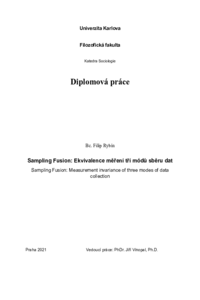Sampling Fusion: Ekvivalence měření tří módů sběru dat
Sampling Fusion: Measurement invariance of three modes of data collection
diploma thesis (DEFENDED)

View/
Permanent link
http://hdl.handle.net/20.500.11956/148229Identifiers
Study Information System: 234466
Collections
- Kvalifikační práce [24136]
Author
Advisor
Referee
Podaná, Zuzana
Faculty / Institute
Faculty of Arts
Discipline
Sociology
Department
Department of Sociology
Date of defense
2. 9. 2021
Publisher
Univerzita Karlova, Filozofická fakultaLanguage
Czech
Grade
Very good
Keywords (Czech)
Výběrové postupy|Smíšený sběr datKeywords (English)
Sampling Fusion|Mixed modesDotazníkové šetření je klíčovým nástrojem zkoumání společenských jevů, stejně jako celá společnost ale prochází vývojem a je potřeba ho podrobovat neustálým analýzám za účelem jeho zlepšení. Přístup smíšených módů sběru dat lze poté využít k hodnocení a srovnání jednotlivých módů na úrovni ekvivalence měření za účelem poukázání na jejich míru přesnosti měření a zhodnocení podobnosti či rozdílnosti. Skrze analýzu politické participace, preference a přesnosti měření pro tři rozdílné módy sběru dat - CATI, CAWI a CAWI s oporou výběru na sociální síti Facebook byly definovány jasné rozdíly jednotlivých módů a poukázáno na vhodnost jejich kombinace pro využití silných stránek, které nabízejí, při současné minimalizaci chyb, které jsou s nimi spojeny.
The questionnaire survey is a key tool for examining social phenomena, but like society as a whole, it is undergoing development and needs to be subjected to constant analysis in order to improve it. The approach of mixed modes of data collection can then be used to evaluate and compare individual modes at the level of measurement invariance in order to point out their degree of measurement accuracy and to evaluate similarity or difference. Through the analysis of political participation, preference and measurement accuracy for three different modes of data collection - CATI, CAWI and CAWI with sampling frame of social network Facebook, clear differences of individual modes were defined and the recommendation of their combination was stated in order to use the strengths they offer, while minimizing the errors associated with them.
